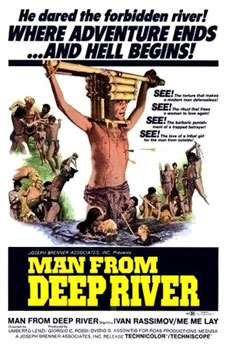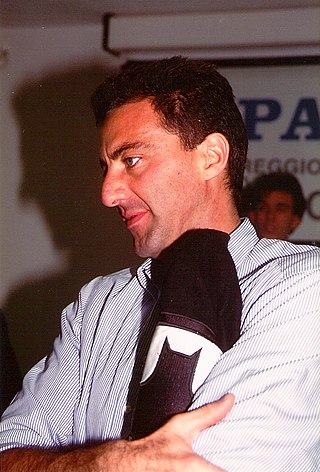
Cannibal Holocaust is a 1980 Italian cannibal film directed by Ruggero Deodato and written by Gianfranco Clerici. It stars Robert Kerman as Harold Monroe, an anthropologist who leads a rescue team into the Amazon rainforest to locate a crew of filmmakers that have gone missing while filming a documentary on local cannibal tribes.

Lamberto Bava is an Italian film director. Born in Rome, Bava began working as an assistant director for his director father Mario Bava. Lamberto co-directed the 1979 television film La Venere d'Ille with his father and in 1980 directed his first solo feature film Macabre.

"Ti Guarderò Nel Cuore", later released under the international title "More", is a pop song adapted from a film score written by Riz Ortolani and Nino Oliviero for the 1962 Italian documentary film Mondo Cane. Ortolani and Oliviero originally composed the melody as an orchestral arrangement that served as the film's theme music. Italian lyrics were provided by Marcello Ciorciolini, which were adapted into English by Norman Newell. It has since become an easy listening and pop standard.

Ruggero Deodato was an Italian film director, screenwriter, and actor.

Cannibal Ferox, also known as Make Them Die Slowly in the US and as Woman from Deep River in Australia, is a 1981 Italian cannibal exploitation horror film written and directed by Umberto Lenzi. Upon its release, the film's US distributor claimed it was "the most violent film ever made". Cannibal Ferox was also claimed to be "banned in 31 countries", although this claim is dubious. The title derives from the Latin ferox, meaning cruel, wild or ferocious.
Impetigo was an American death metal band. They were among the first bands to use clips from films and other media as intros for their songs.
Cannibal films, alternatively known as the cannibal genre or the cannibal boom, are a subgenre of horror films made predominantly by Italian filmmakers during the 1970s and 1980s. This subgenre is a collection of graphically violent movies that usually depict cannibalism by primitive, Stone Age natives deep within the Asian or South American rainforests. While cannibalism is the uniting feature of these films, the general emphasis focuses on various forms of shocking, realistic and graphic violence, typically including torture, rape and genuine cruelty to animals. This subject matter was often used as the main advertising draw of cannibal films in combination with exaggerated or sensational claims regarding the films' reputations.

Ultimo Mondo Cannibale is the debut album by American band Impetigo. It was released in 1990 and was a major influence in the grindcore and goregrind scene. It is one of the first albums to use sound segments from horror films as intros for their songs. Another of the first bands to use this technique is Spanish grindcore band Machetazo.

Il paese del sesso selvaggio, also known as Man From Deep River, Deep River Savages and Sacrifice!, is a 1972 Italian cannibal exploitation film directed by Umberto Lenzi and starring Ivan Rassimov, Me Me Lai and Pratitsak Singhara. It is perhaps best known for starting the "cannibal boom" of Italian exploitation cinema during the late 1970s and early 1980s.

Ultime grida dalla savana, also known as by its English title Savage Man Savage Beast, is a 1975 Italian mondo documentary film co-produced, co-written, co-edited and co-directed by Antonio Climati and Mario Morra. Filmed all around the world, its central theme focuses on hunting and the interaction between man and animal. Like many mondo films, the filmmakers claim to document real, bizarre and violent behavior and customs, although some scenes were actually staged. It is narrated by the Italian actor and popular dubber Giuseppe Rinaldi and the text was written by Italian novelist Alberto Moravia.

Slave of the Cannibal God is a 1978 Italian horror film starring Ursula Andress and Stacy Keach, with English dialogue, that was filmed in Sri Lanka. The film was also widely released in the U.S. in 1979 by New Line Cinema, and released in the U.K. under the title Prisoner of the Cannibal God, with a poster designed by Sam Peffer. The film was banned in the U.K. until 2001 for its graphic violence and considered a "video nasty."

Eaten Alive! is a 1980 Italian horror film directed by Umberto Lenzi. The film is about a young woman who is searching for her sister after her abduction by a cult in the jungles of New Guinea.

Luca Barbareschi is an Italian-Uruguayan actor, television presenter, and former member of the Italian Chamber of Deputies. Barbareschi is Jewish.
Francesca Ciardi is an Italian film actress.
Carl Gabriel Yorke is an American actor.
Perry Pirkkanen is an American actor. He is best known for starring in the 1980 Italian cannibal film Cannibal Holocaust. In the movie he is erroneously credited as 'Perry Pirkanen'. Pirkkanen, then a student at New York City's Actors Studio, was hired by director Ruggero Deodato who was looking for unknown actors to play the film's four main characters. In the film, he was in an infamous scene where he butchered a large turtle. He is even seen holding the turtle's head next to his mouth. However, after filming the scene, he cried and had an emotional breakdown off camera.

Emanuelle and the Last Cannibals is a 1977 Italian sexploitation cannibal film directed by Joe D'Amato. The film involves photojournalist Emanuelle, who encounters a cannibalistic woman bearing a tattoo of an Amazonian tribe in a mental hospital. Along with Professor Mark Lester, the two travel to the Amazon with a team to discover the source of the long-thought-extinct tribe that still practices cannibalism today.
Cannibal Terror is a 1981 French cannibal exploitation film directed by Alain Deruelle and starring Silvia Solar, Pamela Stanford and Oliiver Mathot. Spanish filmmaker Jesús Franco was an uncredited co-writer on the film. Released at the end of the "cannibal boom", the film is a French production, unlike most other cannibal films, which were predominantly made by Italian filmmakers.

Natura contro, also known in English as The Green Inferno and Cannibal Holocaust II, is a 1988 Italian cannibal adventure film directed by Antonio Climati. Climati had no intention of making a sequel to Cannibal Holocaust, and the title was used by distributors of the film to cash in on the success and notoriety of the earlier film.











